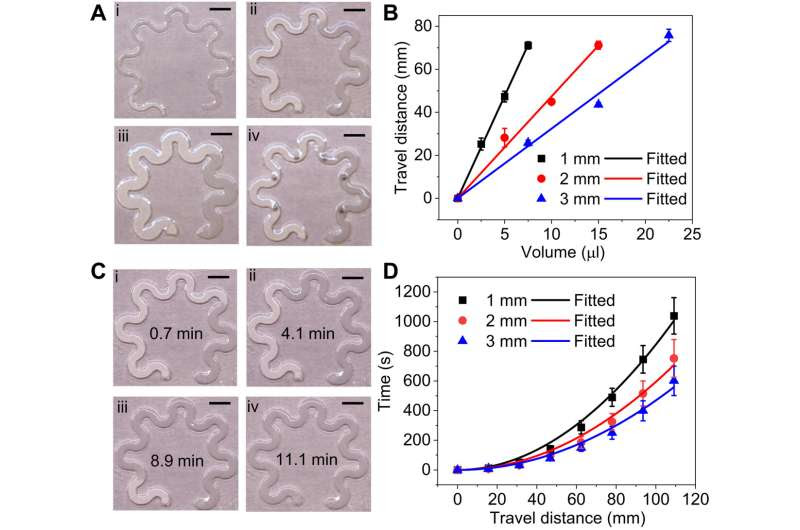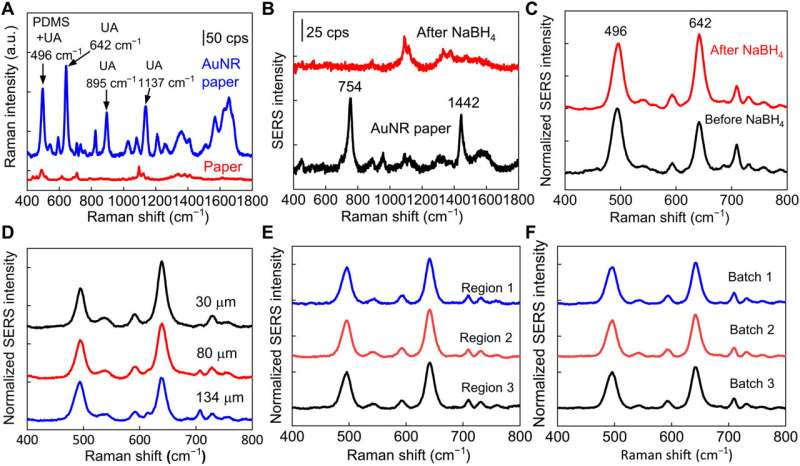by Thamarasee Jeewandara, Medical Xpress

Flow characteristics of paper microfluidic devices. (A) Photographs of serpentine paperfluidic devices with different paper widths of (i) 1 mm, (ii) 2 mm, (iii) 3 mm, and (iv) 2 mm with integrated plasmonic sensors, showing varying travel distances of 10 μl of water. (B) Travel distance as a function of the input liquid volume. (C) Photographs of a 2-mm-wide paperfluidic device showing the increasing liquid travel distance over time from 0.7 to 11.1 min. (D) Relationship between liquid travel time and travel distance in the microfluidic paper with varying channel widths. The solid lines are fitted curves of the experimental data (dots). Scale bars, 5 mm. Credit: Science Advances (2022). DOI: 10.1126/sciadv.abn1736
Wearable sweat sensors play an important role for clinically meaningful information relative to health and disease of individuals. While sensors mainly rely on enzymes and antibodies to achieve specific quantification of stress biomarkers, the enzymes and antibodies can degrade, contributing to poor performance. In a new report now published in Science Advances, Umesha Mogera and a team of scientists in Biomedical Engineering at the Texas A&M University, Texas, U.S., introduced a wearable plasmonic-paper-based microfluidic system to analyze sweat loss, sweat rate and its constituent metabolites, continuously and simultaneously. The team developed plasmonic sensors based on label-free surface-enhanced Raman spectroscopy to provide a chemical fingerprint for analyte identification. They showed detection sensitivity and quantification of uric acid in sweat at physiological and pathological concentrations, and facilitated accurate quantification of the parameters of interest. They engineered the wearable plasmonic device to be soft, flexible and stretchable to cover the skin without inducing chemical or physical irritations.
Measuring uric acid for disease management
Materials scientists have developed a range of physiological sensors to continuously measure physical and chemical biomarkers with applications in disease diagnosis, health monitoring and personalized medicine. Wearable sweat sensors can measure various chemicals in sweat, including electrolytes, metabolites, heavy metals, drugs and hormones to understand pathophysiological impact on the human body. The chloride concentration of sweat can provide standard diagnostic screening parameters for cystic fibrosis, while sweat glucose quantification aims for diabetes management. Similarly, uric acid is also a biomarker of cardio-renal disease and type 2 diabetes. Wearable sweat sensors typically require high sensitivity and environmental stability to accurately quantify biomarkers. In this work, Mogera et al introduced a wearable, plasmonic paper-based microfluidic or paper-fluidic system, to directly capture sweat to continuously and reliably quantify sweat loss, sweat rate and analytes in sweat, in real-time. The scientists used surface-enhanced Raman spectroscopy (SERS) to quantify the concentration of uric acid at physiologically and pathologically relevant concentrations based on the integrated plasmonic nanosensor. The team showed the modes of incorporating thin, soft and flexible plasmonic paperfluidic devices to quantify analytes of varying concentrations.

Wearable plasmonic paper microfluidic device. (A) Conceptual illustration of a wearable plasmonic paperfluidic device for sweat collection, storage, and in situ analysis using SERS. (B) Top view and (C) stacked view schematics of the paperfluidic device highlighting key functional layers. (D) Photograph of an assembled paperfluidic device with six plasmonic sensors. (E) TEM image of gold nanorods (AuNRs) with a uniform size distribution. (F) Extinction spectra of AuNR solution and AuNR paper. a.u., arbitrary units. SEM images of pristine chromatography paper (G) and AuNR paper (H and I). Credit: Science Advances (2022). DOI: 10.1126/sciadv.abn1736Designing the wearable plasmonic paperfluidic device
Mogera et al developed the soft, ultrathin, laminated paperfluidic device for sweat collection at the wrist, for transport, storage and real-time, label-free biochemical analyses using a portable Raman spectrometer. The device showed several advantages with several functional layers, including a double-sided adhesive, laser blocked paper microfluidic layer, plasmonic sensors and an encapsulation layer. The team used a cellulose chromatography paper with a serpentine design to serve as an effective microfluidic channel transporting excreted sweat through the porous medium without external force or inlet pressure. The serpentine design facilitated flexibility and stretchability to accommodate skin movement without interfacial stress or device degradation. Using plasmonic sensors installed at different locations of the paper microfluidic channel, the researchers quantified the concentration of analytes in sweat at different time-points using Raman spectroscopy. Notably, the black carbon double-sided adhesive blocked laser damage to prevent skin irritation during in situ Raman spectroscopy measurements. Mogera et al added a droplet of 10 µL of water and allowed the fluid to pass through the first plasmonic sensor within a minute. For the plasmonic sensors, they used chromatography paper adsorbed with gold nanorods described as AUNRs, which they synthesized, and facilitated retention onto the paper via electrostatic interactions and van der Waals forces.

Plasmonic sensor optimization. (A) Raman spectra of 100 μM UA in 1× PBS collected on pristine paper and AuNR paper. cps, counts per second. (B) Raman spectra of AuNR paper before and after removing surfactants from AuNR with NaBH4, and (C) corresponding SERS spectra of UA collected from AuNR paper. (D) SERS spectra of 100 μM UA with a PDMS encapsulation layer of varying thicknesses. SERS spectra of 100 μM UA collected from (E) different regions of AuNR paper in the same batch and (F) different batches of AuNR paper. Credit: Science Advances (2022). DOI: 10.1126/sciadv.abn1736
Flow characteristics, plasmonic optimization and sensitivity on paperfluidic devices
The research team next quantified the sweat volume and rate via flow characteristics of the microfluidic serpentine paper sandwiched between a top encapsulation made of polydimethylsiloxane (PDMS) and bottom adhesive layers. The fluid uptake volume was linearly proportional to the paper width and liquid travel distance, for a given paper thickness. The scientists characterized the liquid kinetics of the microfluidic paper to quantify real-time sweat rate and quantified the volume and rate, which depended on the location of the device mounted on the body. Mogera et al designed and characterized the AUNR (gold nanorod) paper sandwiched between a microfluidic paper and PDMS for high sensitive detection of uric acid via SERS (surface-enhanced Raman spectroscopy). The concentration ranged from physiological and pathological concentrations in sweat for healthy people, and for those with gout and hyperuricemia. They highlighted a change in intensity following changes in uric acid concentration to confirm the capacity to quantify time-varying uric acid concentrations on the device.
- Application demonstration. Photographs of (A) a device conformally laminated on the forearm of a human subject, (B) under deformation, and (C and D) a portable Raman spectrometer with a flexible fiber probe for spectra collection. SERS spectra of 100 μM UA with the changing distance between the laser source and the plasmonic sensor (E) before and (F) after spectra normalization. (G) Comparison of SERS spectra collected with benchtop and portable spectrometers. (H) Photograph of the device after a healthy human subject wore it and exercised for 20 min. (I) SERS spectrum of the sweat collected from the sensor S1 in (H). Scale bars, 1 cm. Credit: Science Advances (2022). DOI: 10.1126/sciadv.abn1736
- Device flexibility, stretchability, and stability. Photographs of (A) a plasmonic paperfluidic device assembled on a medical adhesive with a paper liner, (B) a freestanding paperfluidic device mounted on a mechanical stretcher at rest state, (C) under 30% stretch, (D) under 60% stretch, (E) a twisted paperfluidic device, and (F) a crumbled paperfluidic device. (G) SERS spectra of UA collected under 0 and 30% strains. (H) Infrared thermal image of a device placed on the hot plate at 45°C with a laser on. (I) SERS spectra of 100 μM UA collected at 21° and 45°C. Scale bars, 1 cm. Credit: Science Advances (2022). DOI: 10.1126/sciadv.abn1736
- Application demonstration. Photographs of (A) a device conformally laminated on the forearm of a human subject, (B) under deformation, and (C and D) a portable Raman spectrometer with a flexible fiber probe for spectra collection. SERS spectra of 100 μM UA with the changing distance between the laser source and the plasmonic sensor (E) before and (F) after spectra normalization. (G) Comparison of SERS spectra collected with benchtop and portable spectrometers. (H) Photograph of the device after a healthy human subject wore it and exercised for 20 min. (I) SERS spectrum of the sweat collected from the sensor S1 in (H). Scale bars, 1 cm. Credit: Science Advances (2022). DOI: 10.1126/sciadv.abn1736
- Device flexibility, stretchability, and stability. Photographs of (A) a plasmonic paperfluidic device assembled on a medical adhesive with a paper liner, (B) a freestanding paperfluidic device mounted on a mechanical stretcher at rest state, (C) under 30% stretch, (D) under 60% stretch, (E) a twisted paperfluidic device, and (F) a crumbled paperfluidic device. (G) SERS spectra of UA collected under 0 and 30% strains. (H) Infrared thermal image of a device placed on the hot plate at 45°C with a laser on. (I) SERS spectra of 100 μM UA collected at 21° and 45°C. Scale bars, 1 cm. Credit: Science Advances (2022). DOI: 10.1126/sciadv.abn1736
Proof-of-concept and outlook
The soft and ultrathin stretchable double-sided adhesive and PDMS encapsulated paperfluidic device provided a flexible platform with inherently assembled functionality, which withstood mechanical deformation and temperature variations. As proof of concept, the researchers tested the performance of paperfluidic devices for sweat collection and analysis in healthy humans. The subjects wore the device easily by applying it to any location, due to its soft mechanical construction. The team quantified a concentration of 28 µm sweat in healthy individuals. In this way, Umesha Mogera and colleagues established a wearable plasmonic paperfluidic platform to collect sweat, transport, store and conduct real-time, label-free biochemical analysis. The SERS provided a chemical fingerprint of sweat metabolites without incorporating any biorecognition elements. The team used the setup to measure the sensitivity and quantify uric acid concentrations as low as 1 µm. They envision future advances of miniaturized and wearable optical readout systems to propel the plasmonic devices into real-world applications for disease diagnosis and health monitoring.

Leave a Reply